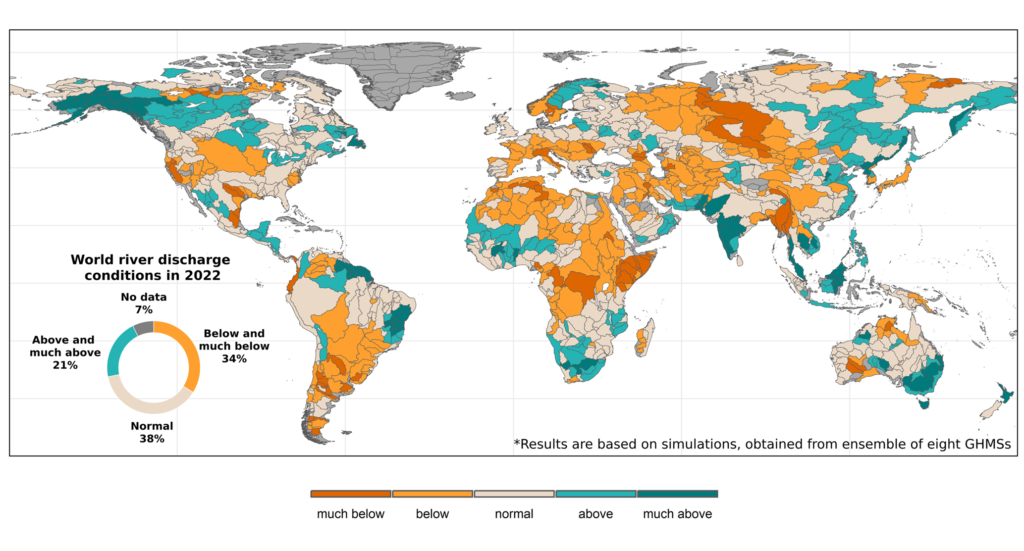Physical Address
23,24,25 & 26, 2nd Floor, Software Technology Park India, Opp: Garware Stadium,MIDC, Chikalthana, Aurangabad, Maharashtra – 431001 India
Physical Address
23,24,25 & 26, 2nd Floor, Software Technology Park India, Opp: Garware Stadium,MIDC, Chikalthana, Aurangabad, Maharashtra – 431001 India

The World Meteorological Organization has sounded an alarm on the increasingly imbalanced hydrological cycle due to climate change and called for a critical shift in policy towards improved monitoring.
Severe droughts and extreme rainfall events are inflicting significant damage on both livelihoods and economies, a report released by the agency on Thursday says. The thawing of snow, ice, and glaciers is amplifying risks like floods and posing a long-term threat to the water security of millions of people.
“Glaciers and ice cover are retreating before our eyes. Rising temperatures have accelerated – and also disrupted – the water cycle. A warmer atmosphere holds more moisture. We are seeing much heavier precipitation episodes and flooding. And at the opposite extreme, more evaporation, dry soils and more intense droughts,” said WMO Secretary-General Petteri Taalas in a statement as the agency released its State of Global Water Resources report for 2022.
This report offers a comprehensive analysis of global water resources emphasizing the need for a fundamental policy change and advocating for enhanced monitoring, data exchange, and collaboration to address these challenges.
“The overwhelming majority of disasters are water-related and so water management and monitoring lies at the heart of the global Early Warnings For All initiative. Many of the countries targeted for priority action in Early Warnings for All suffered from major floods or droughts in 2022. Not a single country had timely and accurate hydrological data available to support evidence-based decision making and early action,” Prof Taalas added.

Key Findings:
Hydrological Aspects
The report conducts a comprehensive global evaluation of water resources, with over 50% of catchment areas experiencing deviations from typical river discharge conditions in 2022. More than 60% of major water reservoirs received below-average inflow, mirroring anomalies in soil moisture and evaporation.
A shift from La Niña to El Niño conditions in 2023 is expected to impact the hydrological cycle.
Cryospheric Changes
The Third Pole, encompassing the Tibetan Plateau and the Himalayas, is essential for the water supply of nearly 2 billion people. Glacier mass balance decreased by over 4% from 2000 to 2018, affecting river runoffs, says the report.
Snow cover in the Alps and glacier mass in the European Alps remained significantly below average.
The subtropical Andes experienced reduced winter snow accumulation, impacting water availability for Chile and Argentina.
Water-Related Disasters
Severe droughts had wide-ranging consequences in Europe, affecting river transportation and nuclear electricity production. Low water levels disrupted navigation on the Mississippi River in the USA, says the report.
The La Plata river basin in South America faced prolonged drought, leading to reduced hydropower production and water supply issues.
Drought in the Yangtze River Basin in China resulted in lower river discharge, reservoir inflow, and soil moisture.

The Horn of Africa experienced a protracted humanitarian crisis due to extended drought, while the Niger Basin and South Africa saw above-average river discharge linked to significant flood events.
Pakistan’s Indus River Basin endured a catastrophic flood event, causing substantial losses due to a combination of glacier meltwater and monsoon rainfall, says the report.
This is only the second report of its kind from WMO, examining river basins, groundwater, evaporation, soil moisture, and reservoir inflow. It builds on the previous year’s pilot report, offering more comprehensive insights into hydrological elements and providing policymakers with a valuable resource.
Currently, over 3.6 billion people face limited access to water for at least one month per year, with projections indicating this will affect more than 5 billion by 2050, as noted by UN-Water.
If you have any queries or come across suspicious content related to climate change or the environment and want us to verify them, send them to Climate Buddy, our WhatsApp tipline +91 70453 66366.
ALSO READ:
How Climate Change is impacting natural springs in India
World heading towards severe water crisis, Climate Change a big factor